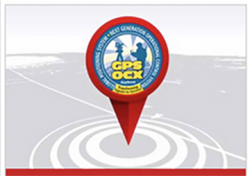 The GPS III SV03 fully assembled. Photo courtesy of Lockheed Martin.
The GPS III SV03 fully assembled. Photo courtesy of Lockheed Martin.The U.S. Air Force’s third GPS III satellite in production flow at Lockheed Martin’s advanced satellite manufacturing facility in Denver is now fully integrated into a complete space vehicle.
GPS III Space Vehicle 03 (GPS III SV03) followed the first two GPS III satellites on a streamlined assembly and test production line. Technicians successfully integrated the satellite’s major components – its system module, navigation payload and propulsion core – into one fully-assembled space vehicle on August 14.
By Inside GNSSAir Force Space Command announced Wednesday it will begin the next phase of its plan to buy another 22 GPS III satellites in two weeks.
The November 22 posting on Fed Biz Opps (fbo.gov) said the highly anticipated Request for Proposals (RFP) would be released on or about December 7. The contract for the new space vehicles is "planned as a single, predominantly Fixed Price Incentive-type contract awarded via full and open competition for production of 22 GPS III SVs."
By Inside GNSSThe Global Positioning Systems Directorate, which is poised to launch its procurement of another 22 GPS III satellites, has given its next tranche of spacecraft a name.
"We are officially calling this GPS IIIF," Col. Gerry Gleckel, the Directorate’s deputy director, told the November meeting of the National Space-Based Positioning, Navigation, and Timing (PNT) Advisory Board. "Just as there was a IIF that was the follow-on for the GPS II’s, this is the follow-on for the GPS III."
By Dee Ann Divis Photo Credit: ssuaphotos/Shutterstock.com
Photo Credit: ssuaphotos/Shutterstock.comEsterline CMC Electronics and NovAtel Inc. just announced a new strategic partnership, extending their collaboration in Global Navigation Satellite System (GNSS) positioning technology that started in the late 1990s. The partnership will see NovAtel’s industry-leading GNSS measurement technology integrated into a new Esterline CMC-designed multi-constellation, multi-frequency (MCMF) chipset for certified aviation use.
By Inside GNSS Photo courtesy of GPS.gov.
Photo courtesy of GPS.gov. House and Senate authorizers are forcing a reorganization of the Pentagon’s management of military space programs, giving authority to a soon-to-be-named official to prioritize space budgets across services and setting planning in motion for a possible new department. They also approved spending the full amounts requested for the military GPS programs and mandated that defense officials both test a backup to GPS and look at incorporating European and Japanese GNSS signals into military user equipment.
By Inside GNSS The advanced MDU on navigation payloads being delivered for GPS III Space Vehicles 1-10. Photo courtesy of Harris Corp.
The advanced MDU on navigation payloads being delivered for GPS III Space Vehicles 1-10. Photo courtesy of Harris Corp.Harris Corporation has completed development of the company’s fully digital Mission Data Unit (MDU), which is at the heart of its navigation payload for Lockheed Martin’s GPS III satellites 11 and beyond.
By Inside GNSS
The Space and Missile Systems Center (AFSPC) announced today that the United States Air Force has accepted delivery of the Global Positioning System Next Generation Operational Control System (GPS OCX) Launch and Checkout System (LCS) baseline from Raytheon Intelligence and Information Systems.
By Inside GNSS Kenneth Hudnut will receive the 2017 Ivan I. Mueller Award for Distinguished Service and Leadership in December. Photo courtesy of Kenneth Hudnut.
Kenneth Hudnut will receive the 2017 Ivan I. Mueller Award for Distinguished Service and Leadership in December. Photo courtesy of Kenneth Hudnut.Kenneth Hudnut, a contributing writer and former columnist for Inside GNSS, will receive the 2017 Ivan I. Mueller Award for Distinguished Service and Leadership at the 2017 American Geophysical Union Fall Meeting, to be held December 11-15 in New Orleans, La. The award acknowledges “major achievements in service to and/or leadership within the field of geodesy.”
By Inside GNSS
The long-running, high stakes battle between the GPS community and Ligado Networks may enter a new phase next month when the firm presents to the nation’s leading GPS experts its plan to develop a combined terrestrial/satellite network using its spectrum neighboring the GPS band.
By Inside GNSSWhile it is understood that the internet, cell phones and air traffic systems rely on GPS technology to function smoothly, so too do other unexpected elements of the nation’s infrastructure — including millions of miles of underground pipelines.
By Dee Ann Divis
Key details are emerging about how Air Force managers are working to pull into line the substantially delayed and over budget program to build a new GPS ground system.
By Inside GNSS GPS III SV01 now awaits a call up to begin pre-launch preparations. Photo: Lockheed Martin.
GPS III SV01 now awaits a call up to begin pre-launch preparations. Photo: Lockheed Martin.Ushering in a new era of advanced Global Positioning System technology, the U.S. Air Force this week declared the first Lockheed Martin-built GPS III satellite “Available for Launch.”
The Air Force’s “AFL” declaration is the final acceptance of Lockheed Martin’s first GPS III Space Vehicle (GPS III SV01) prior to its expected 2018 launch. GPS III SV01 will bring new capabilities to U.S. and allied military forces, and a new civil signal that will improve future connectivity worldwide for commercial and civilian users.
By Inside GNSS